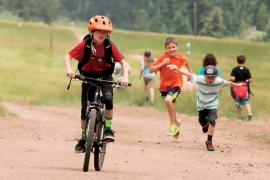I spent a few months earlier this year visiting camps throughout New England. One of my stops was Camp Watitoh, a sleepaway camp in the Berkshire Mountains in Massachusetts, where a college classmate and friend of mine is now a co-director. While Camp Watitoh is coed, it has separate campus areas for boys and girls. I arrived a bit worn out from a red-eye flight and the subsequent drive, but became immediately energized by lush green playing fields filled with enthusiastic campers. After taking a few hours to recharge, I made my way to the dining hall and took my place among the tables of campers and counselors. I watched with interest as a group of 14- to 16-year-old boys, affectionately known as the “Waiters,” served meals family style and were treated with reverence by the other campers. I came to learn that these young men participated in regular camp programs but ate earlier and were responsible for serving the three meals a day at camp. As part of the Waiter program, the boys’ version of a counselor-in-training program at Watitoh, they learned their way around the kitchen and proper hygiene for food service. Among other responsibilities, they juggled food requests, brought out substitutes when campers and staff requested alternatives to the main course, and cleared tables after campers and counselors had stacked their dishes.
It might seem easy to dismiss the Waiters as a way to efficiently manage mealtime, but I quickly realized the multilayered genius s of the t r ad it ion. The program had a deep influence on camp spirit and culture, and also on the waiters themselves. The younger boys saw the waiters as the “big brothers” of camp and aspired to someday be like them, and all campers formed a special bond with the waiter who was assigned to their table throughout the summer. The waiters found their names included in lyrics of repurposed camp songs and cheers proclaiming appreciation and gratitude. Waiters were the leaders of the boys’ side of camp, leading the spirit and brotherhood on campus and setting the tone for other campers. It was clear the young men treated their role as an honor; they became engaged and enthused about every activity from the camp sing-a-long to square dancing to color wars in a way most boys their age typically are not.
As someone who has spent he past 15 years teaching organization, time-management, and life skills to teens and young adults, I found the Waiter program represented the magic created through the power of camp. By promoting leadership and community building in an authentic way, it also empowers teen boys to develop crucial executive functioning and communication skills. The waiters are repeatedly in front of an audience of supportive, grateful peers and staff members, learning how to juggle multiple tasks with ease. The self-confidence and self-awareness that results surely has year-round benefits.
A Crisis for Boys
Parents and educators have long spoken on the seeming crisis in boys’ education. Boys, on average, are graduating from high school and college at lower rates than girls (Greene, 2006), and for the first time in history , 20-something men earn, on average, less than their female counterparts (Rousu, 2014). Some of the background reasons for these troubling trends include schools’ heightened academic expectations, as excessive performance pressure around standardized testing sometimes creates a toxic and stressful environment for students. Well-meaning parents often hover instead of letting their children make the natural mistakes that promote social and emotional growth and, in doing so, inadvertently prevent children from developing intrinsic motivation and self-confidence. Increased technology and social media use create distractions that can make it even harder for students to focus and concentrate, and can contribute to sleep deprivation. Sleep deprivation has a host of side effects, including decreased productivity. All of these factors contribute to what I call “The crippling fear of the unwise choice,” where boys become so paralyzed from the fear of making the wrong choice that they make no choice at all (Homayoun, 2010). Those combined factors can thoroughly alter the way a boy thinks about himself and his role in the world. Finding strategies to motivate boys in an experiential way can promote organization, time-management, and goal-setting skills. When young men become invigorated by their own potential and possibilities that can boost them into becoming engaged in greater community in ways once thought to be impossible.
One of the reasons boys and young men have been struggling in our current school and work environment is that we — and by “we” I mean parents, educators, and even boys themselves — often assume boys should be able to juggle multiple tasks at once with little time for transition or processing. It is mistakenly assumed they shouldn’t need training to develop those abilities in a supportive, encouraging way. In terms of brain development, boys are on average one to three years behind girls, and that difference is most apparent during the middle school and high school years. A young woman’s brain typically reaches full maturity around age 21, while a young man’s brain is still developing until around 24 years old (this explains so much, I know).
There is some evidence that the part of the brain that deals with organization of tasks and impulsivity, including the pre-frontal cortex that regulates impulsivity and control, isn’t fully developed in pre-teen and teen boys. Coupled with today’s increased focus on technology and less emphasis placed on continued face-to-face communication and collaborative interaction, many boys simply haven’t been given the opportunity and environment necessary to set them up for success in a meaningful way.
How Camp Helps Develop Skills
Which brings me back to camp and, in particular, the Waiter program and other skill-building camp traditions. I often state that all teenagers should work in food service or another service-related industry as a way to build responsibility, collaboration, and communication skills. The Waiter program is an example of a camp-infused program that develops skills boys need to be successful year round in a way that still allows them to be kids and play. It is, quite simply, an example of how camp can be the best of all worlds.
There are other ways to promote success and skill development for all campers, regardless of age, and create a culture that supports the continued development of campers, counselors, and camp leaders. But many camp directors express continued frustration on certain issues that, while not exclusive to boys, do seem to affect boys at a greater rate.
One camp director of a sleepaway camp pointedly exclaimed that “any and all transitions and laundry” were his male campers’ (and counselors’) biggest organizational challenges. At the same time, behavioral issues often stem from two ends of the spectrum — either sheer inactivity and lack of engagement or utter exhaustion. More and more boys experience some form of social and emotional anxiety, which can be related to a fear of new experiences and the unknown, or can be a result of technology withdrawal. For young boys who typically spend more than 53 hours a week on some form of media (Kaiser Family Foundation, 2010) coming to a camp with less technological access can also be a big shift.
One of the simplest and yet often most effective solutions is adjusting a camp schedule to build in more structure around life-skills tasks. Many male campers haven’t yet learned to self-regulate or self-motivate, and I find some of my most disorganized students have the most organized parents. If transitions never seem to happen fast enough, reframe expectations and create more time in the camp schedule for transitions so campers (and counselors) aren’t always feeling rushed. Find ways to “gamify” even the most mundane tasks to promote a sense of fun with everyday chores like cleaning up after lunch or getting ready for bed. A timer and a bit of properly calibrated enthusiasm can work wonders on boys’ engagement — because much of the success is about attitude and approach.
Boys also thrive when camp schedules simultaneously allow for intense activity and movement followed by ample opportunities for mindful stillness and rest. When I visit camps and evaluate their schedules, I find there is sometimes too much packed in too little time, and the ability for true rest is nonexistent. By the middle of a camp session, that nonstop movement and sleep-deprived state can lead to more emotional outbursts, less self-management, and more overall stress for everyone involved. Creating a schedule where mornings are filled with intense movement enables boys to use their energy in a positive way and gives them a gentle endorphin rush to start the day. Alternating periods of intense activity with noticeable rest is key to maximize enthusiasm and engagement while also allowing for proper recharge and rejuvenation.
When it comes to building organization and time-management skills, it’s easy to underestimate the consistent repetition and structure needed for long-term adaptation. Daily and weekly “re-group” times give boys the opportunity to get everything — their cabin, their dining table, their day pack, even their sock drawer — back in order and begin to imprint habits as their own. Over time, the small, repeated, and incremental success helps them gain the confidence that comes with such success. Camps (and schools) often don’t build in these routines as part of the schedule because it is wrongly assumed boys will find a way to take care of those tasks themselves. (Counselors appreciate re-group times for themselves too.) While some campers certainly can, others are far from there yet, and failing to realize that leads to frustration for campers and camp staff alike.
Having campers collaborate together on solutions also creates the opportunity for leadership and responsibility in a confidence-building way. A boy who successfully transitions between activities or consistently figures out how to organize his laundry can be a leader in charge of encouraging his peers. Pairing campers of different ages allows all involved to repeat and reinforce habits that will help year-round.
Finally, when it comes to promoting more diverse social engagement among boy campers, it helps to routinely create opportunities for open socialization, or changes. With so much time spent in front of screens today, all campers benefit from proactively promoted chances to socialize with people new to them. Introductions and icebreakers are typically the hardest, especially as boys get older. Something as easy as building a camp culture around meeting three to five new campers per week (depending on the size of camp and the length of sessions) creates an atmosphere of openness and inclusiveness. It’s no longer seen as a Herculean task when it’s simply a routine part of the camp experience because everyone is doing it.
I loved the Waiter program because it incorporates the development of organization, time-management, prioritization, and collaboration skills in a seamless way that positively benefits campers and influences the camp culture and community. Each camp has the opportunity to support the ongoing growth and development of boys in such a critical stage of their lives by looking at their own traditions and finding ways to encourage success. In doing so, even the most ordinary of tasks can become the time of their lives and the beginning of lifetime dreams never before imagined.
Photos on page 40–41 courtesy of Camp Rockmont, Black Mountain, North Carolina.
References
Greene, J., and Winters, M. (2006, April). Leaving boys behind: Public high school graduation rates. Civic Report 48. Retrieved from www.manhattan-institute.org/html/cr_48.htm
The Henry J. Kaiser Family Foundation (2010, January 20). Generation M2: Media in the lives of 8- to 18-year-olds. Retrieved from http://kff.org/other/event/generation-m2-media-in-the-lives-of/
Homayoun, A. (2010). That crumpled paper was due last week: Helping disorganized and distracted boys succeed in school and life. New York, NY: Perigee.
Rousu, M. (2014, February 24). Childless women in their twenties out-earn men. So? Forbes. Retrieved from www.forbes.com/sites/realspin/2014/02/24/childless-women-in-their-twent…
Ana Homayoun is a teen and millennial expert who draws on her camp experiences, among others, to help individuals, schools, and corporations with organization, personal productivity, and overall wellness. She can be reached through her website at www.anahomayoun.com.



